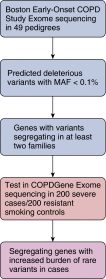Exome Sequencing Analysis in Severe, Early-Onset Chronic Obstructive Pulmonary Disease
- PMID: 26736064
- PMCID: PMC4910887
- DOI: 10.1164/rccm.201506-1223OC
Exome Sequencing Analysis in Severe, Early-Onset Chronic Obstructive Pulmonary Disease
Abstract
Rationale: Genomic regions identified by genome-wide association studies explain only a small fraction of heritability for chronic obstructive pulmonary disease (COPD). Alpha-1 antitrypsin deficiency shows that rare coding variants of large effect also influence COPD susceptibility. We hypothesized that exome sequencing in families identified through a proband with severe, early-onset COPD would identify additional rare genetic determinants of large effect.
Objectives: To identify rare genetic determinants of severe COPD.
Methods: We applied filtering approaches to identify potential causal variants for COPD in whole exomes from 347 subjects in 49 extended pedigrees from the Boston Early-Onset COPD Study. We assessed the power of this approach under different levels of genetic heterogeneity using simulations. We tested genes identified in these families using gene-based association tests in exomes of 204 cases with severe COPD and 195 resistant smokers from the COPDGene study. In addition, we examined previously described loci associated with COPD using these datasets.
Measurements and main results: We identified 69 genes with predicted deleterious nonsynonymous, stop, or splice variants that segregated with severe COPD in at least two pedigrees. Four genes (DNAH8, ALCAM, RARS, and GBF1) also demonstrated an increase in rare nonsynonymous, stop, and/or splice mutations in cases compared with resistant smokers from the COPDGene study; however, these results were not statistically significant. We demonstrate the limitations of the power of this approach under genetic heterogeneity through simulation.
Conclusions: Rare deleterious coding variants may increase risk for COPD, but multiple genes likely contribute to COPD susceptibility.
Trial registration: ClinicalTrials.gov NCT00608764.
Keywords: chronic obstructive pulmonary disease; genetic association studies; segregation analysis.
Figures






Comment in
-
The Advent of High-Throughput Sequencing Studies of Chronic Obstructive Pulmonary Disease.Am J Respir Crit Care Med. 2016 Jun 15;193(12):1323-4. doi: 10.1164/rccm.201601-0074ED. Am J Respir Crit Care Med. 2016. PMID: 27304235 Free PMC article. No abstract available.
Similar articles
-
Whole-Genome Sequencing in Severe Chronic Obstructive Pulmonary Disease.Am J Respir Cell Mol Biol. 2018 Nov;59(5):614-622. doi: 10.1165/rcmb.2018-0088OC. Am J Respir Cell Mol Biol. 2018. PMID: 29949718 Free PMC article.
-
Exome Array Analysis Identifies a Common Variant in IL27 Associated with Chronic Obstructive Pulmonary Disease.Am J Respir Crit Care Med. 2016 Jul 1;194(1):48-57. doi: 10.1164/rccm.201510-2053OC. Am J Respir Crit Care Med. 2016. PMID: 26771213 Free PMC article.
-
Extreme Trait Whole-Genome Sequencing Identifies PTPRO as a Novel Candidate Gene in Emphysema with Severe Airflow Obstruction.Am J Respir Crit Care Med. 2017 Jul 15;196(2):159-171. doi: 10.1164/rccm.201606-1147OC. Am J Respir Crit Care Med. 2017. PMID: 28199135 Free PMC article.
-
Applying Functional Genomics to Chronic Obstructive Pulmonary Disease.Ann Am Thorac Soc. 2018 Dec;15(Suppl 4):S239-S242. doi: 10.1513/AnnalsATS.201808-530MG. Ann Am Thorac Soc. 2018. PMID: 30759001 Free PMC article. Review.
-
[Familial predisposition to chronic obstructive pulmonary disease].Pneumonol Alergol Pol. 2009;77(4):407-10. Pneumonol Alergol Pol. 2009. PMID: 19722147 Review. Polish.
Cited by
-
Genetics of chronic obstructive pulmonary disease: understanding the pathobiology and heterogeneity of a complex disorder.Lancet Respir Med. 2022 May;10(5):485-496. doi: 10.1016/S2213-2600(21)00510-5. Epub 2022 Apr 12. Lancet Respir Med. 2022. PMID: 35427534 Free PMC article. Review.
-
A Genome-Wide Linkage Study for Chronic Obstructive Pulmonary Disease in a Dutch Genetic Isolate Identifies Novel Rare Candidate Variants.Front Genet. 2018 Apr 19;9:133. doi: 10.3389/fgene.2018.00133. eCollection 2018. Front Genet. 2018. PMID: 29725345 Free PMC article.
-
Genetic Advances in Chronic Obstructive Pulmonary Disease. Insights from COPDGene.Am J Respir Crit Care Med. 2019 Sep 15;200(6):677-690. doi: 10.1164/rccm.201808-1455SO. Am J Respir Crit Care Med. 2019. PMID: 30908940 Free PMC article. Review.
-
Whole-Genome Sequencing in Severe Chronic Obstructive Pulmonary Disease.Am J Respir Cell Mol Biol. 2018 Nov;59(5):614-622. doi: 10.1165/rcmb.2018-0088OC. Am J Respir Cell Mol Biol. 2018. PMID: 29949718 Free PMC article.
-
The Advent of High-Throughput Sequencing Studies of Chronic Obstructive Pulmonary Disease.Am J Respir Crit Care Med. 2016 Jun 15;193(12):1323-4. doi: 10.1164/rccm.201601-0074ED. Am J Respir Crit Care Med. 2016. PMID: 27304235 Free PMC article. No abstract available.
References
-
- Mannino DM, Homa DM, Akinbami LJ, Ford ES, Redd SC. Chronic obstructive pulmonary disease surveillance--United States, 1971-2000. Respir Care. 2002;47:1184–1199. - PubMed
-
- Hersh CP, Demeo DL, Silverman EK. Chronic obstructive pulmonary disease. In: Silverman EK, Shapiro SD, Lomas DA, Weiss ST, editors. Respiratory genetics. London: Hodder Arnold: 2005. pp. 253–296.
Publication types
MeSH terms
Supplementary concepts
Associated data
Grants and funding
- R01 HL113264/HL/NHLBI NIH HHS/United States
- R01 HL089897/HL/NHLBI NIH HHS/United States
- RC2 HL102923/HL/NHLBI NIH HHS/United States
- U54 HG006493/HG/NHGRI NIH HHS/United States
- P01 HL083069/HL/NHLBI NIH HHS/United States
- RC2 HL102926/HL/NHLBI NIH HHS/United States
- K08 HL097029/HL/NHLBI NIH HHS/United States
- R01 HL075478/HL/NHLBI NIH HHS/United States
- R01 HL089856/HL/NHLBI NIH HHS/United States
- RC2 HL102924/HL/NHLBI NIH HHS/United States
- P01 HL105339/HL/NHLBI NIH HHS/United States
- K01 HL129039/HL/NHLBI NIH HHS/United States
- UM1 HG006493/HG/NHGRI NIH HHS/United States
- RC2 HL103010/HL/NHLBI NIH HHS/United States
- RC2 HL102925/HL/NHLBI NIH HHS/United States
- R01 HL084323/HL/NHLBI NIH HHS/United States
LinkOut - more resources
Full Text Sources
Other Literature Sources
Medical
Research Materials
Miscellaneous

